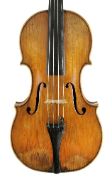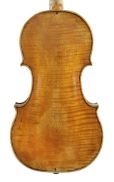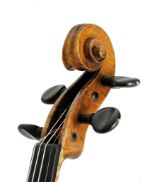Violin, Camillo Camilli, Mantua, 1736
Handwritten label: “Camillus Camilli Fecit / Mantua 1736.”Camillo Camilli’s instruments display some characteristics that distinguish him from other makers. A case in point is the short body model with long C-bouts. Short corners let the C-bouts appear very open. The two-piece belly made of spruce displays annual rings of medium width. A dendrochronological report showed that the two halves of the belly are likely to have been taken from the same log. The most recent annual ring was dated 1706. The one-piece, slab-cut back exhibits vivid flaming that is especially pronounced on the bass side. The ribs have a similar appearance. The body exhibits medium-high arching, with the arching height of the back greater than that of the belly. The edgework and the purfling are flawlessly executed. The wide black strips of the inlay are an unusual feature of this violin. Its f-holes are very cleanly cut. The width of the upper and lower wings is nearly the same, as in other instruments by the master. Unlike the back plate and the ribs, the pegbox and scrollfeature little flaming. The maple wood used for these parts is known by its Italian name oppio, a type of wood commonly used in violinmaking. With its very regular and well-proportioned volutes, the scroll showcases skilled craftsmanship. As a rule, Camilli used a light varnish with golden-yellow hues. Its appearance is somewhat harsh, but admirably highlights the quality of the wood.





